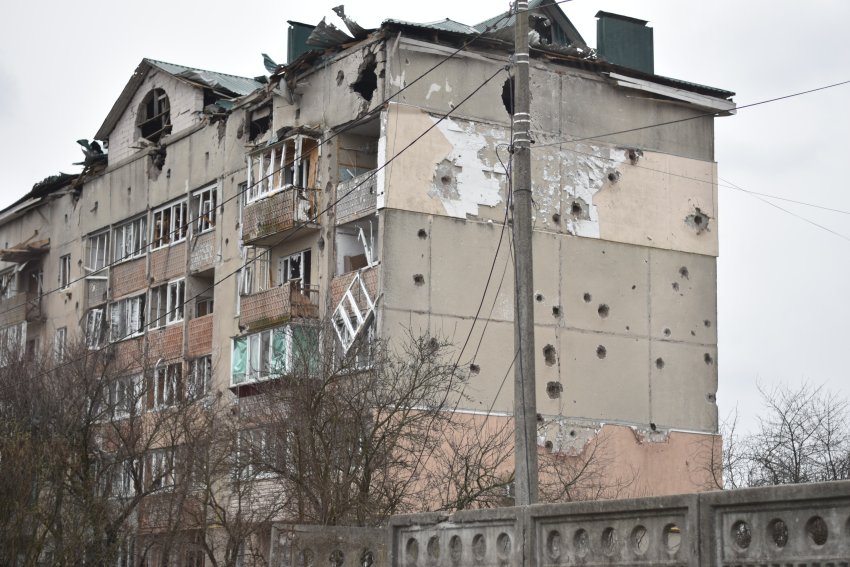
Russia’s war against Ukraine has had devastating consequences for the country’s economy and society.
In March, after the beginning of the war, Ukraine’s gross domestic product (GDP) shrank by 45% compared to the previous year. In the second quarter, GDP fell by a staggering 37.2%. For the whole of 2022, the World Bank estimates that Ukraine’s economy will shrink by 35%; other estimates predict that the contraction could be as much as 40%.
The war has also massively increased Ukraine’s trade deficit. By September, it had more than doubled to reach $6.1 billion. Agricultural exports — which netted $27.8 billion in 2021 and comprised 41% of total exports — were particularly hard hit because Russia seized Ukrainian ports on the Sea of Azov and some on the Black Sea, while mined others, bottling up 20 million tons of grain plus other food products earmarked for export.
Before the war, only 2.5% of Ukrainians lived in extreme poverty. However, the war abruptly changed this. According to estimates of the World Bank, the number of Ukrainians in extreme poverty will likely increase tenfold in 2022 and by the end of next year, it might reach about 50% of the population. Furthermore, the National Bank of Ukraine reports that unemployment had reached 35% by the second quarter of 2022.
As a result of the direct effects of the war as well as of the devastating deterioration of living conditions, one-third of the country’s 44 million people have been displaced: 6.5 million within Ukraine and almost 8 million as refugees in other European countries.
A large part of Ukraine’s energy infrastructure has been destroyed by the relentless Russian missile and drone attacks which take place nearly every day.
While the exact amount of damage is difficult to assess, there is no doubt that it is gigantic. According to the World Bank, Ukraine's recovery and reconstruction needs a total of at least $349 billion, which is more than 1.5 times the size of Ukraine’s pre-war economy. The Kyiv School of Economics estimated in May that total infrastructure losses in Ukraine could amount to $600 billion. It also estimated at that time that about $4.5 billion of war-related damage occurs with every passing week. If their calculations are correct, then in the past six or so months, at least another $100 billion in damage has been done. Another report estimates the costs for reconstructing Ukraine could be up to $750 billion.
Yuriy Gorodnichenko, a Ukrainian-born economist from the University of California, Berkeley, has done some preliminary research into what it might cost to rebuild Ukraine. He wrote in a report: “We can also look at other measures and similar efforts that were done in the past. For example, what was the cost of reconstructing Iraq or Afghanistan? If you look at the size of these countries, the level of damage, and scale it to the Ukrainian case, you come to somewhere between $500 billion, maybe $1 trillion.”
Bear in mind that all these estimations are based on the current level of destruction of Ukraine. Every further month of occupation and aggression by Russian imperialism will inevitably increase the damage and, hence, the costs for reconstruction.
The leaders of Western imperialist governments boast about their “generous” support for Ukraine. “The global community has been providing support for Ukraine for several months. The G7 states, the European Union and its members have raised over 35 billion euros in emergency aid alone to date.” However, this is only a tenth of the lowest estimation of damage as mentioned above.
Faced with the enormous costs of the war and such wide scale destruction, Ukraine is struggling to cover the budget deficit for next year. Defence spending is six times higher in the 2023 budget recently passed by the Ukrainian parliament compared to last year. Military and security spending will total 43% of the budget, or 18.2% of annual GDP.
As a result, half of Ukraine’s budget of 2.6 trillion hryvnia is not covered by fiscal revenue. This means that the government needs to find $3 billion to $5 billion a month to cover the gap. President Volodymyr Zelenskyy says Ukraine needs $38 billion in outright aid from Western allies plus $17 billion for a reconstruction fund for war damage. Economists associated with the Kyiv School of Economics say a lower overall total of $50 billion from donors would be enough to get Ukraine through the year.
Ukraine’s structural problems are aggravated by the fact that Western aid is often in the form of loans and not grants. As a result, the country’s indebtedness to foreign imperialist institutions is massively increasing. In 2021, it was already 69% of Ukraine's annual GDP. This level has now reached – due to economic collapse as well as new loans – about 83% and is supposed to rise to over 100% soon.
This means that Ukraine’s indebtedness to the imperialist powers will increase even more. Western financial institutions are making huge profits with loans to the Ukraine. Heidi Chow, executive director at the Jubilee Debt Campaign, calculated some months ago that “if Ukraine continues to make its debt payments, Western banks and hedge funds could make profits of 300 percent”.
All these horrible developments demonstrate why it is urgent for socialists to support Ukraine against Vladimir Putin’s invasion (without lending any support to NATO imperialism). Likewise, it is essential that socialists around the globe – and particularly in Western countries – campaign for the total cancellation of Ukraine’s foreign debts!
[Michael Pröbsting is a socialist activist who writes on imperialism and Great Power rivalry. He is the editor of the website, thecommunists.net. Visit links.org.au for a longer version of this article, including references.]